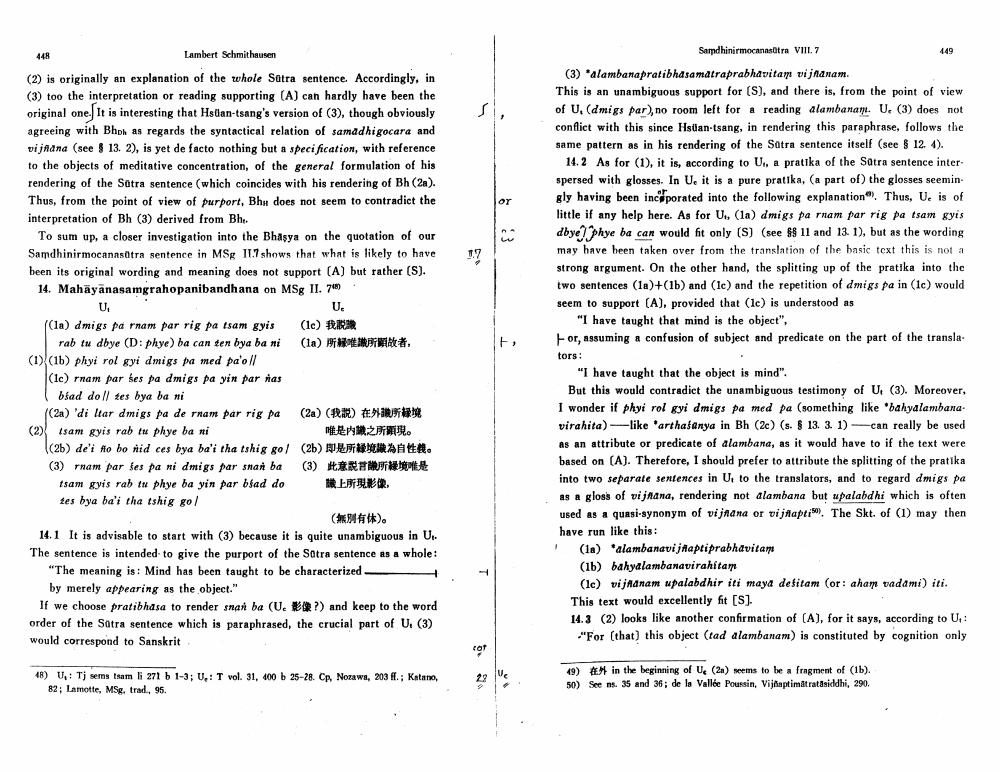Book Title: On Vinaptimatra Passage In Samadhinirmocanasutra VIII Author(s): L Schmithausen Publisher: L Schmithausen View full book textPage 9
________________ Sardhinirmocannatra VIII. 7 449 448 Lambert Schmithausen (2) is originally an explanation of the whole Satra sentence. Accordingly, in (3) too the interpretation or reading supporting (A) can hardly have been the original one. It is interesting that Hsuan-tsang's version of (3), though obviously agreeing with Bhoh as regards the syntactical relation of samadhi gocara and vijnana (see 13. 2), is yet de facto nothing but a specification, with reference to the objects of meditative concentration, of the general formulation of his rendering of the Satra sentence (which coincides with his rendering of Bh (2n). Thus, from the point of view of purport, Bhe does not seem to contradict the interpretation of Bh (3) derived from Bh. To sum up, a closer investigation into the Bhasya on the quotation of our Samdhinirmocanestra sentence in MSR 117 shows that what is likely to have been its original wording and meaning does not support (A) but rather (S). 14. Mahayanasamgrahopanibandhana on MSg II. 70 ((la) dmigs pa nam par rig pa sam gyis (le) RRRR rab in dbye (D: phye) ha can ten bya ba ni (1a) WW W . (1){(16) phyi rol gyi dmigs pa med pa'oll (Ic) rnam par ses pa dmigs pa yin par nas bśad doll tes bya ba ni (2a) 'di ltar dmigs pa de rnam par rig pa (2a) (RIRE (2) Isam gyis rab tu phye ba ni MR. (2b) de'i Mo bo nid ces bya ba'i tha tshig go! (2b) WU R AA (3) rnam par les pa ni dmigs par snart ba (3) tsam gyis rab tu phye ba yin par bfad do ERR Les bya ba'i tha Ishig go! (E84 ). 14.1 It is advisable to start with (3) because it is quite unambiguous in U.. The sentence is intended to give the purport of the Sotra sentence as a whole: "The meaning is: Mind has been taught to be characterized - by merely appearing as the object." If we choose pratibhasa to render snart ba (U. #R?) and keep to the word order of the Satra sentence which is paraphrased, the crucial part of U. (3) would correspond to Sanskrit (3) 'alambanapratibhasamatraprabhavita vijnanam. This is an unambiguous support for (S), and there is, from the point of view of U, (dmigs par), no room left for reading alambanan. U. (3) does not conflict with this since Hsuan-tsang, in rendering this paraphrase, follows the same pattern as in his rendering of the Satra sentence itself (see $ 12.1). 14.2 As for (1), it is, according to U., a pratika of the Satra sentence inter spersed with glosses. In U, it is a pure pratika, (a part of the glosses seemingly having been incoporated into the following explanation". Thus, Ue is of little if any help here. As for U.. (la) dmigs pa ram par rig pa sam gyis dbye? Phye ba can would fit only (S) (see $ 11 and 13. 1), but as the wording may have been taken over from the translation of the basie text this is not a strong argument. On the other hand, the splitting up of the pratika into the two sentences (1a)+(1b) and (Ic) and the repetition of dmigs pain (le) would seem to support (A), provided that (1c) is understood as "I have taught that mind is the object", or, assuming a confusion of subject and predicate on the part of the translators: "I have taught that the object is mind". But this would contradict the unambiguous testimony of U. (3). Moreover, I wonder if phyi rol gyi dmigs pa med pa (something like 'bahyalambana. virahita) - like 'arthafanya in Bh (2) (s. $13.3 1) —can really be used as an attribute or predicate of alambana, as it would have to if the text were based on (A). Therefore, I should prefer to attribute the splitting of the pratika into two separate sentences in U, to the translators, and to regard dmigs pa As a gloss of vijana, rendering not alambana but upalabdhi which is often used as a quasi-synonym of vijnana or vijflaptis. The Skt. of (1) may then have run like this: (la) *alambanavij Aaptiprabhavitam (lb) bahyalambanavirahitarr (le) vijanam spalabdhir iti maya defitam (or: ahar vadami) iti. This text would excellently fit (S). 14.3 (2) looks like another confirmation of (A), for it says, according to U.: "For (that) this object (tad alambanan) is constituted by cognition only o 18) U,: Tim tram li 271 b 1-3; U,: T vol. 31, 400 b 25-28. CA Nonaws. 200 f.; Katam, 82; Lamotte, MSc. trad. 95. 19) * in the beginning of Uç (2) seems to be a fragment of (lb). 50) See ns. 35 and 36; de la Vallée Poussin, Vijapimtitratasiddhi, 290.Page Navigation
1 ... 7 8 9 10 11 12
